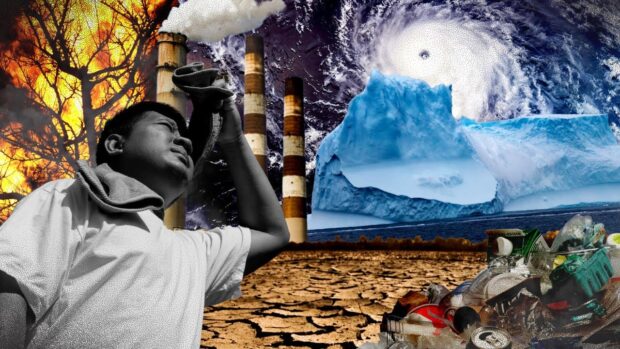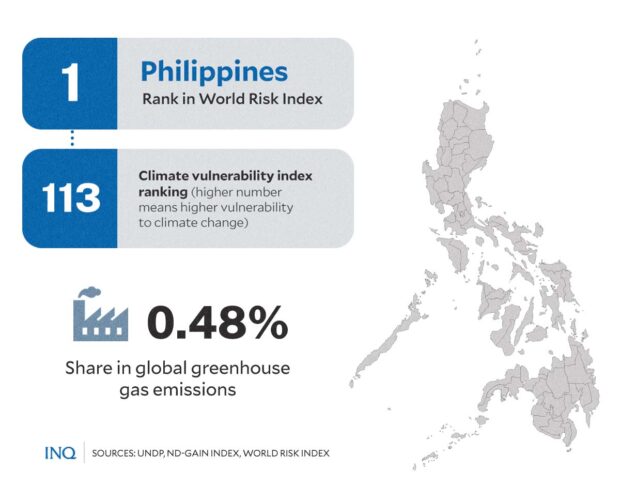It’s going to get 1.5-degree C hotter by 2027, scientists warn

COMPOSITE IMAGE: JEROME CRISTOBAL FROM INQ STOCK/FILE PHOTOS
MANILA, Philippines—For the first time ever, global temperatures are likely to set new record highs in the next five years due to heat-trapping greenhouse gases (GHG) and a naturally occurring El Niño event, according to an update issued by the World Meteorological Organization (WMO).
WMO, a specialized United Nations (UN) agency, revealed in a report released last May 17 that global temperatures are “now more likely than not” to breach 1.5°C of warming within the next five years.
The highest global average surface temperature recorded in previous years was 1.28°C above pre-industrial levels. The average global temperature recorded in 2022 was about 1.15°C above the 1850-1900 average.
The report said that there is a 66 percent likelihood that the annual average near-surface global temperature between 2023 and 2027 will exceed 1.5°C above pre-industrial levels for at least one year.
The organization stressed that it is unlikely that the five-year mean will exceed this threshold.
“The annual mean global near-surface temperature for each year between 2023 and 2027 is predicted to be between 1.1°C and 1.8°C higher than the 1850-1900 average. This is used as a baseline because it was before the emission of greenhouse gases from human and industrial activities,” the report stated.
ALSO READ: Scorching summer and heat index: Dos and Don’ts
According to WMO, the chance of temporarily exceeding 1.5°C has risen steadily since 2015, when it was close to zero. Between 2017 and 2021, there was a 10 percent chance of breach.
Last year’s report by the organization put the odds at about 50-50.
“Global mean temperatures are predicted to continue increasing, moving us away further and further away from the climate we are used to,” said Dr. Leon Hermanson, a Met Office expert scientist who led the report.
However…
The WMO, however, explained that the new data means that the world would cross the 1.5°C above pre-industrial long-term warming threshold set out in the 2015 Parisclimate deal.
“This report does not mean that we will permanently exceed the 1.5°C level specified in the Paris Agreement which refers to long-term warming over many years. However, WMO is sounding the alarm that we will breach the 1.5°C level on a temporary basis with increasing frequency,” said WMO Secretary-General Prof. Petteri Taalas in a statement.
Over 190 nations that have signed up to the 2015 Paris climate agreement pledged to limit the global average temperature rise to well below 2°C above pre-industrial levels and to further limit the temperature increase to hit the 1.5°C threshold.

GRAPHIC Ed Lustan
Hermanson noted that temporarily reaching 1.5°C is “an indication that as we start having these years with 1.5°C happening more and more often, than we are getting closer to having the actual long-term climate be on that threshold.”
A report by the World Economic Forum explained that it also means “the world has failed to make sufficient progress on slashing climate-warming greenhouse gas emissions.”
The chance of soon hitting 1.5°C was partially boosted by the expected El Niño weather pattern developing in the coming months.
“A warming El Niño is expected to develop in the coming months and this will combine with human-induced climate change to push global temperatures into uncharted territory,” said Taalas.
“This will have far-reaching repercussions for health, food security, water management, and the environment. We need to be prepared,” he added.
PH urges developed nations
The Philippines, which committed to a projected greenhouse gas (GHG) emissions reduction and avoidance of 75 percent, called for “bolder” climate action from developed nations.
According to Environment Secretary Maria Antonia Yulo Loyzaga, developing countries such as the Philippines “hardly” contribute to greenhouse gas emissions but continue to suffer the most and bear the brunt of climate change.

GRAPHIC Ed Lustan
Data from the 2019 CAIT Climate Data Explorer showed that the country’s share of global GHG emissions is at 0.48 percent, yet its vulnerability to climate change remains high.
The 2022 World Risk Index identified the Philippines as the most disaster-prone country in the world due to its high risk, exposure, and vulnerability to disasters and calamities.
“As developing countries need resources for climate adaptation, the Philippine delegation will continue calling on developed countries to step up to these obligations and deliver without delay on their commitments on climate finance, technology transfer and capacity building,” said Loyzaga, the head of the country’s delegation to COP27 held last year.
The world’s largest emitters of greenhouse gases according to data from the Center for Climate and Energy Solutions were China, the United States, and members of the European Union.
RELATED STORIES
Pagasa warns of danger as extreme heat prevails in Cebu: What to do?
Heat index in Cebu reaches 38 degrees Celsius
Teachers’ group in Central Visayas seeks modular classes setup due to intense heat
Disclaimer: The comments uploaded on this site do not necessarily represent or reflect the views of management and owner of Cebudailynews. We reserve the right to exclude comments that we deem to be inconsistent with our editorial standards.
